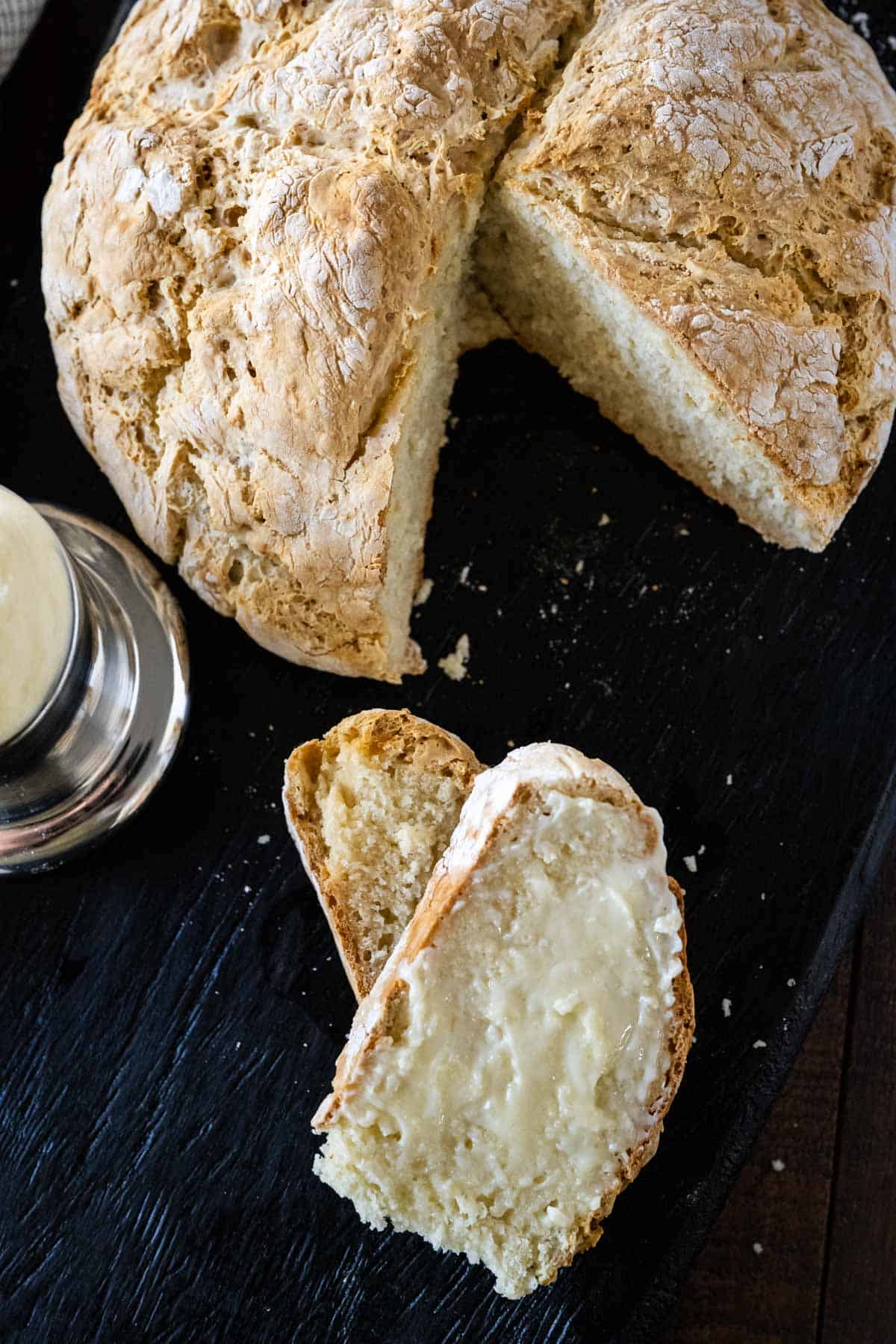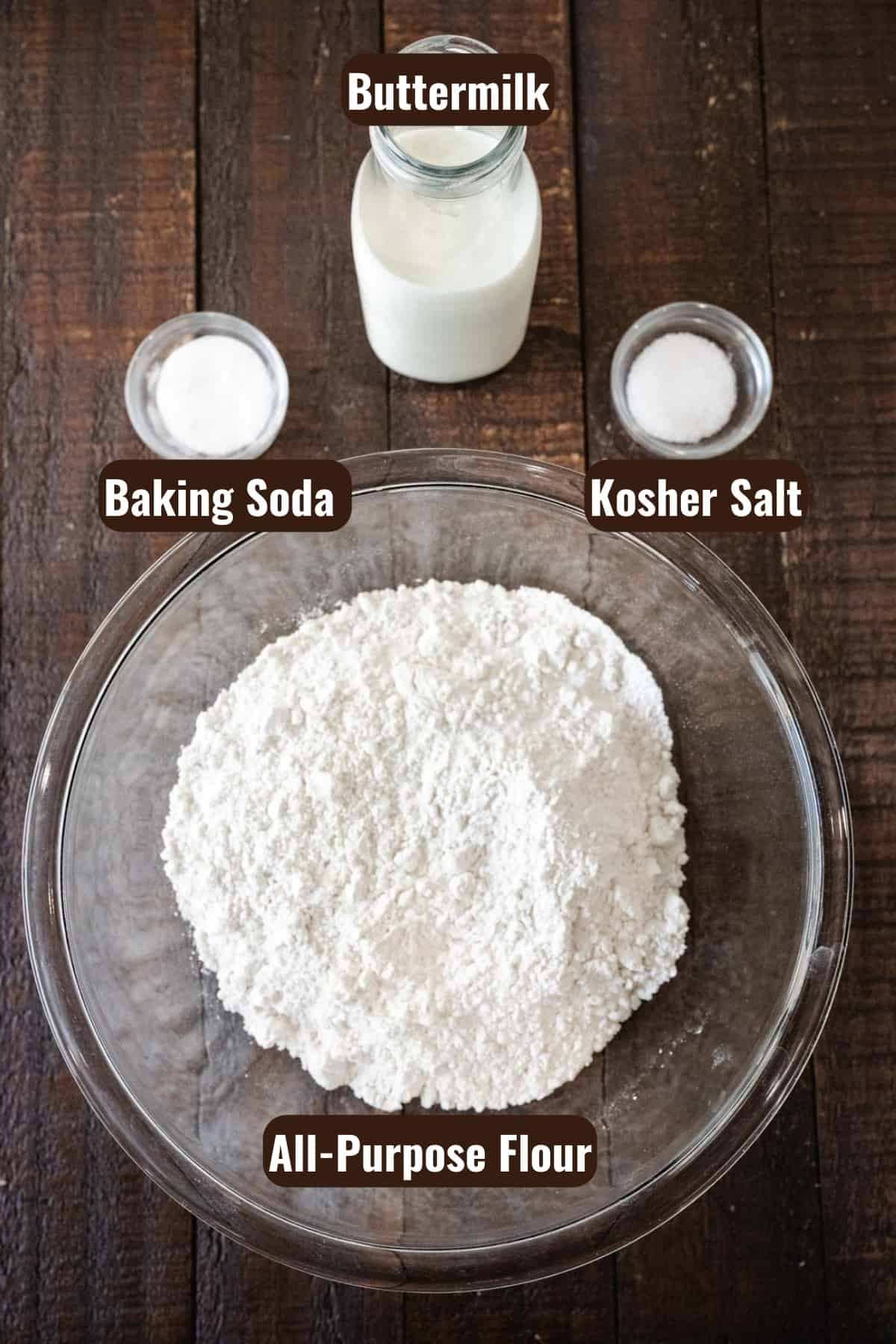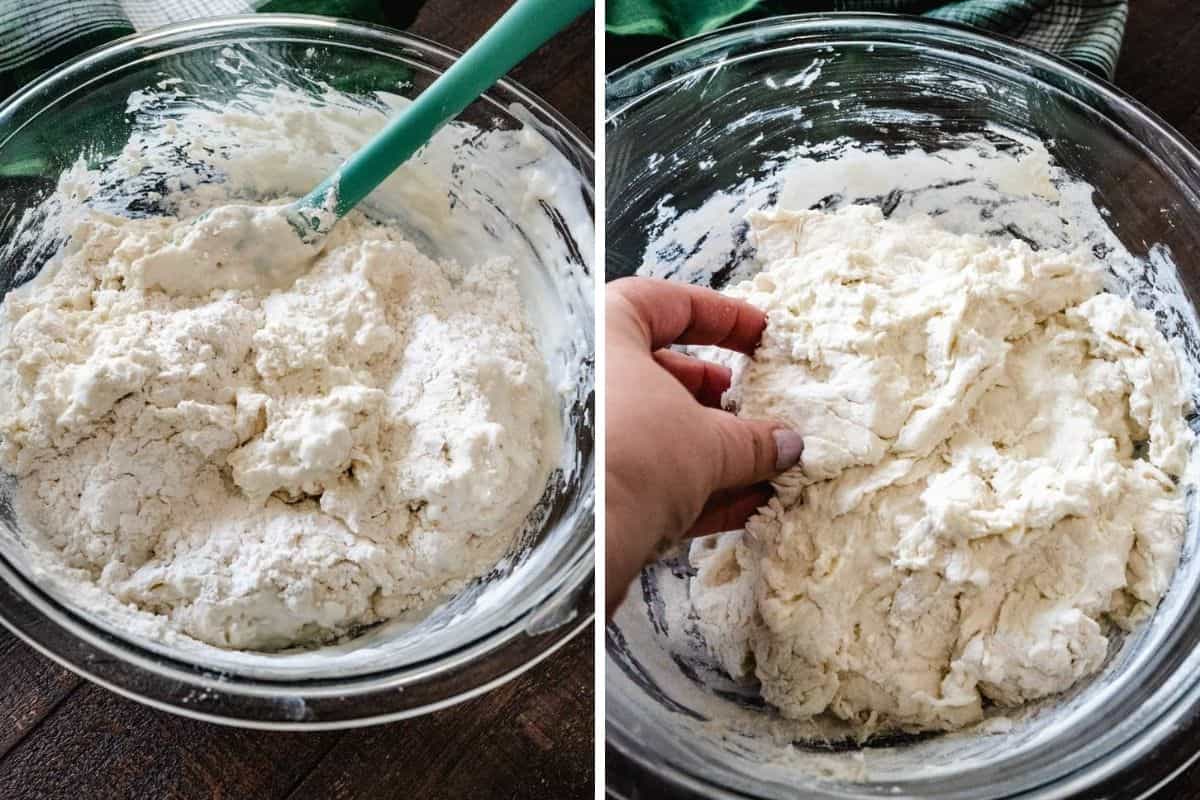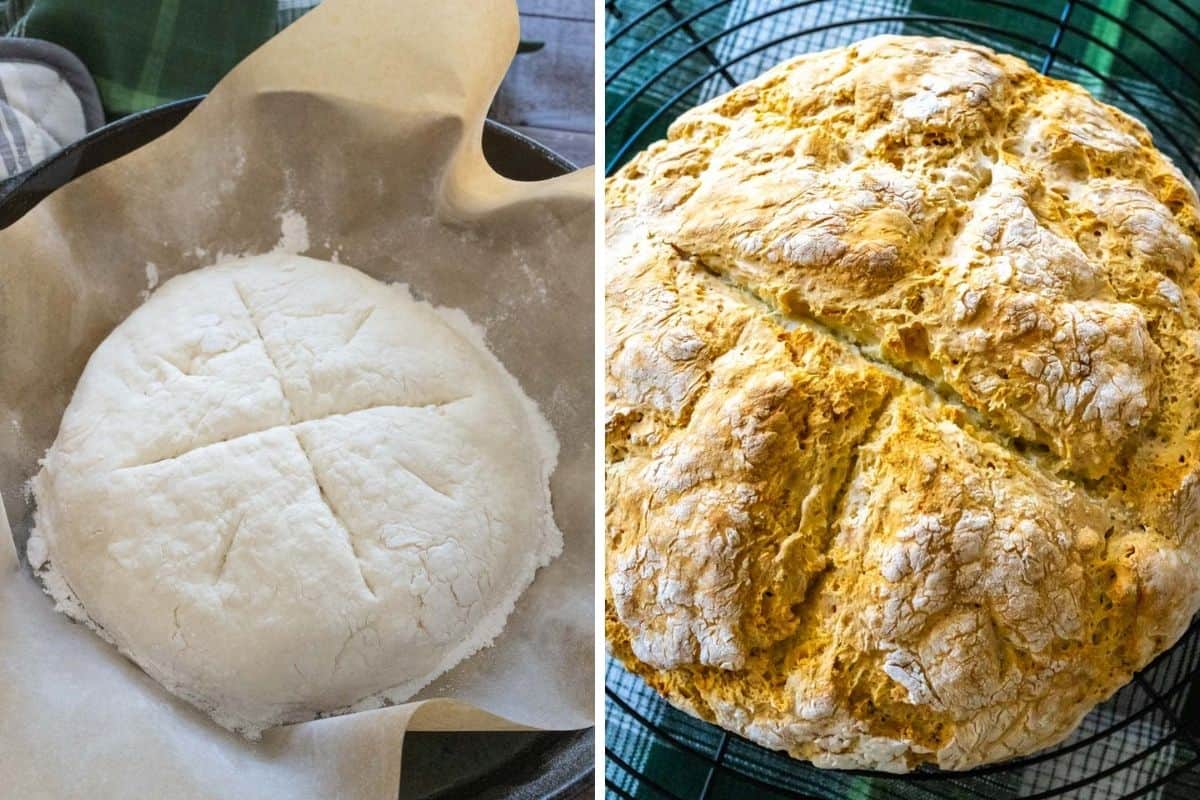This post may contain affiliate links. Please read our disclosure policy.
Traditional Irish Soda Bread is a 4 ingredients, 5-minute recipe that is ready in 45 minutes. This no yeast bread requires no rising time yets bakes up a rustic hearty crust with a beautifully moist dense crumb!
You don’t need the luck of the Irish to create this masterpiece. It’s quite easy and straightforward. Combine, mix, form a simple dough, and bake!
All you need is to top it with a slather of butter or to dunk it in a warm soup and you are all set!

Why you’ll love this recipe!
- Quick No Yeast Bread: The dough comes together in 5 minutes and ready in under an hour. No yeast needed and no waiting for it to rise and kneading and rise.
- 4 Ingredients: Minimal ingredients on hand, but want a homemade bread. This is the perfect bread recipe. These are pantry staple items you likely already have at home.
- Forgiving: Making this bread is really quite easy and the dough is very forgiving. You don’t have to be a bread making expert.
What is Irish Soda Bread?
I am not sure there is anything better than the aroma of fresh baking bread. Along with that often comes a process to achieve a beautiful loaf of bread.
This Irish Soda Bread Recipe is a no yeast bread with no rise time resulting in a loaf you can bake any night of the week!
It is called Irish Soda Bread because it is made with baking soda instead of yeast. It’s a very rustic bread with a dense inside and nice crusty outside. This is quite different from soft white bread, while still having an airy crumb, as you would find in a typical loaf of bread.
Here in America, St. Patrick’s Day is usually when you find this bread making its way into our kitchens. During this time of year, we are all about cooking up delicious Irish recipes.
However, this recipe is one you can bake any time of the year. It’s the perfect homemade bread to dunk in a soup, chili, or stew. Or even just to enjoy a slice slathered in creamy butter – heaven in a bite!
Why not bake up a loaf at home? It literally takes 5 minutes to stir the ingredients together and then it’s into the oven.
Here’s what you will need.

Ingredients

How to make 4 Ingredient Irish Soda Bread
Step 1 | Prepare Oven and Baking Tray
- Preheat oven to 425°F. If using a baking sheet line it with parchment paper. You can also use a cast-iron skillet or a dutch oven.
Step 2 | Prepare Dough

- In a large bowl whisk together 3 cups of all-purpose flour, salt, and baking soda. Create a well in the center and add in the buttermilk, starting with 1 ¾ cups adding more as needed.
- Gradually add in more flour as needed to achieve a dough that is firm and not overly sticky, while stirring to combine.

Step 3 | Form Dough and Cut Cross on top
- Lightly flour work surface with about 2 tablespoons of flour. Turn the dough out onto the work surface and lightly top with another 2 tablespoons of flour
- Lightly knead it until it forms a smooth ball (This isn’t a typical bread that requires kneading. You are just forming it into shape.) Gradually add in more flour if needed only if dough is still too sticky.
- Using a sharp knife cut a cross on top of the loaf (about ½ inch deep).

Want to Save this Recipe?
By submitting this form, you consent to receive emails from Soulfully Made.
Step 4 | Bake and Enjoy
- Place dough on a prepared baking sheet or cast-iron pan.
- Bake in the oven for 20 minutes on 425°F. Then turn the oven down to 400°F.
- Then bake another 20 minutes, or until the base sounds hollow when tapped in the middle.
- Transfer to a cooling rack for 30 minutes.

Then cut a slice and enjoy!

Tips
- Dough stickiness: Start with less flour and add more flour as required. It’s better to have a sticky dough and add to it. The trick is to use just enough flour to make the dough manageable because stickier dough = more moist bread.
- If your dough isn’t sticky enough add a splash of buttermilk at a time until you get the right consistency.
- The amount of flour will vary: So many things affect the dough – humidity, temperature, type of flour, the brand of flour are just a few. Most of the time 3 ½ cups of flour works fine, but just add flour a little at a time (¼ cup) until you get a dough that isn’t too sticky.
- Don’t knead the bread too much: This is a no yeast bread so the less you handle it the softer the crumb will be. You really are just combining and forming a ball more than really kneading the dough.

Frequently Asked Questions
Traditional Irish Soda Bread doesn’t use eggs or butter. Eggs make the bread less moist and using butter will make the crumb and texture less tender.
You should have an expiration date on your container. However, if you can’t find it or just want to test to see if it is fresh, place 1/2 teaspoon of baking soda in a small bowl. Add 3 tablespoons of plain vinegar. It should bubble vigorously. If there are only a few bubbles or no bubbles at all, then you need to replace your baking soda
Yes, you really do need the buttermilk’s acidity to react with the baking soda to produce bread. I really recommend having buttermilk because of the creamy thickness that results in the process of making buttermilk. If you are in a pinch you can make a substitute, just keep in mind you may need to use a little less as it will be a thinner consistency than its substitute.
If you don’t have buttermilk, you can make your own substitution. The basic ratio to make one cup buttermilk is: 1 tablespoon vinegar or lemon juice to a measuring cup and then add milk to the 1 cup mark. Stir to combine and let sit 5 to 10 minutes. For this recipe use 2 tablespoons vinegar and fill to the 2 cup mark.

Variations and Substitutions:
This version is a simple traditional 4 ingredient soda bread. It is full of flavor with a nice salty taste and can be enjoyed as-is or with creamy butter. Want to change it up from time to time? Here are a few ideas:
How to Store Irish Soda Bread
Store wrapped well or in an airtight container or zip bag for 3 at room temperature or in the refrigerator for 4 to 5 days. After that, it will begin to dry out.
You can also freeze it for 2 to 3 months.

Looking for more St. Patrick’s Day Recipes?
Other Quick and Easy Bread Recipes
Hungry for more easy, home-cooked, delicious recipes?
Sign up for my free recipe club to get family-friendly recipes in your inbox each week! Find me sharing daily meal-time inspiration on Pinterest, Facebook, and Instagram.

4 Ingredient Irish Soda Bread Recipe
Ingredients
- 3 ½ to 4 cups all-purpose flour, plus 4 tablespoons for work and dough surface
- 1 ½ teaspoon baking soda
- 1 teaspoons salt
- 1 ¾ to 2 cups buttermilk, cold
- 1 cup raisins, (optional)
Instructions
- Preheat oven to 425°F. If using a baking sheet line it with parchment paper. You can also use a cast-iron skillet or a dutch oven.
- In a large bowl whisk together 3 cups of all-purpose flour, salt, and baking soda. Create a well in the center and add in the buttermilk, starting with 1 ¾ cups adding more as needed. Gradually add in more flour as needed to achieve a dough that is firm and not overly sticky. While stirring to combine.
- Lightly flour work surface with about 2 tablespoons of flour. Turn the dough out onto the work surface and lightly top with another 2 tablespoons of flour
- Lightly knead it until it forms a smooth ball (This isn't a typical bread that requires kneading. You are just forming it into shape.) Gradually add in more flour as needed to achieve a dough that is firm and not sticky.
- Place dough on a prepared baking sheet or cast-iron pan. Using a sharp knife cut a cross on top of the loaf (about ½ inch deep).
- Bake in the oven for 20 minutes on 425°F. Then turn the oven down to 400°F.
- Then bake another 20 minutes, or until the base sounds hollow when tapped in the middle.
- Transfer to a cooling rack for 30 minutes before cutting.
Want to Save this Recipe?
By submitting this form, you consent to receive emails from Soulfully Made.
Notes
- Dough stickiness: Start with less flour and add more flour as required. It’s better to have a sticky dough and add to it. The trick is to use just enough flour to make the dough manageable because stickier dough = more moist bread.
- If your dough isn’t sticky enough add a splash of buttermilk at a time until you get the right consistency.
- The amount of flour will vary: So many things affect the dough – humidity, temperature, type of flour, the brand of flour are just a few. Most of the time 3 ½ cups of flour works fine, but just add flour a little at a time (¼ cup) until you get a dough that isn’t too sticky.
- Don’t knead the bread too much: This is a no yeast bread so the less you handle it the softer the crumb will be. You really are just combining and forming a ball more than really kneading the dough.
Nutrition Information
Nutritional Disclaimer
Soulfully Made is not a dietician or nutritionist, and any nutritional information shared is only an estimate. We recommend running the ingredients through an online nutritional calculator if you need to verify any information.
©️Soulfully Made
